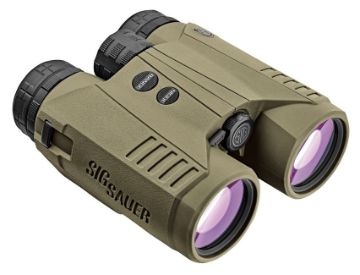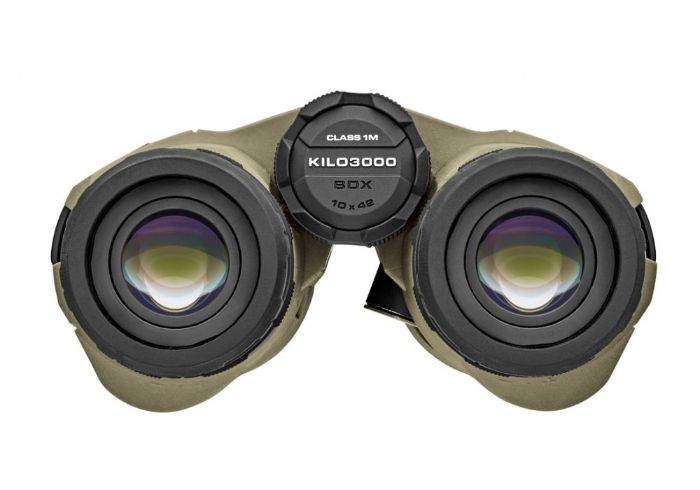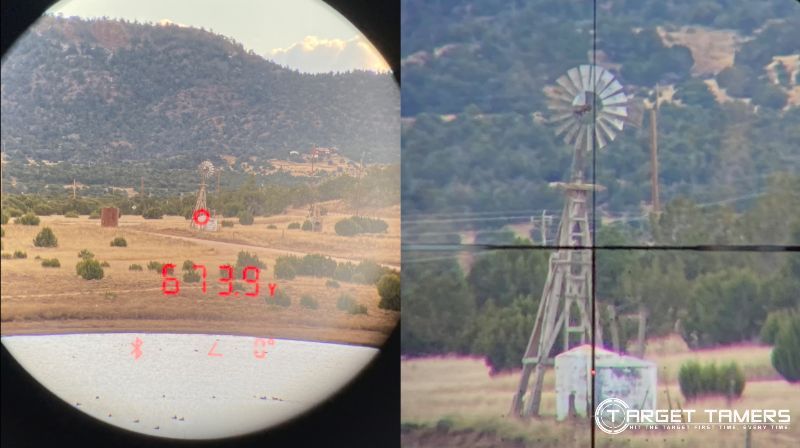Most other rangefinders are named after their max ranging capability, but not the Sig.
The Kilo 3000 BDX has a max range of 5000 yards but is named after its medium reflectivity performance (trees, rocks, etc.) at around 2500-3000 yards.
This puts it up with the best long-ranging binoculars like the Vortex Fury HD 5000 AB.
Much like the Vortex version, it has Bluetooth, Applied Ballistics, and a 1.5 mrad beam divergence.
Now’s the time to pick a side.
Whose team are you on?
Quick Overview...
What We Like: Quality build
What We Don’t Like: Optical quality
Best Uses: Hunting, Bow Hunting, Target Shooting, Long-Range, Angle Compensation, Ballistics, Bluetooth, Illumination
- Yard Range: 5000
- Magnification: 10x
- Objective Lens: 42mm
- Display Type: LED
- Dimensions: 5.75 x 2.5 x 5”/31 oz
- Waterproof/Fogproof: Yes/Yes
- Angle Compensation: Yes

Our Verdict: The KILO 3000 BDX is one of the most affordable smart Bluetooth ranging binoculars available. If it’s all about budget, the KILO is your best option.
Who is the Sig Sauer KILO 3000 BDX Best Suited to?
The Sig Sauer KILO 3000 BDX is talked about constantly across the board. If you already have BDX gear, it’s a no-brainer to go the Kilo 3000 BDX route. We like it so much we have it featured on our best binoculars under $1000 article.
When it came to determining if it had the “it factor” to be reviewed, it blew the Athlon Cronus 10X50 UHD out of the water.
Not that the Cronus UHD isn’t good, but the Kilo BDX is better, and Sig provides a lot more at a very competitive price point.
Another rangefinder binocular that could match the Kilo is the Vortex Fury HD 5000 AB. The Vortex, however, comes with a lifetime warranty versus the 5-year electronic warranty on the Kilo… something to think about.
How Does the Sig Sauer KILO 3000 BDX Perform?
In all honestly, the KILO 3000 BDX is not unlike alternatives in the market. They’re all essentially using the same AB Ultralite solver program. The difference will lie in the on-board features, glass quality, ease of app use, and stable Bluetooth connectivity.
Given the popularity of the Kilo BDX, it does a great job. But it still stands to reason that its most attractive feature is its lower street price. Given that rangefinder binoculars are expensive to begin with and then adding Bluetooth and Applied Ballistics, you’re looking at an optic that costs over $1500 on the low end.
As far as the AB goes, it’s competitive with the best alternatives in the market. It’s tripod mountable which is a very big deal. It’s currently one of the cheapest range binos in the market. Where has the Kilo cut corners?
While there are mixed, but mostly good, feelings about the glass quality, it doesn’t have the best of what we know Sig can offer. The AB is not upgradable from Ultralite to Elite, but you can use a Kestrel to get “more” if that’s what you want. Sig is notorious for not dishing out lens caps and that proves to a big downer with buyers.
You should also be aware that there is an accessory package difference in whether you buy the Black Kilo (#31004) or the OD Green Kilo (#31001) model.
Features & Benefits

Quality Build
While definitely not as outstanding as a Leica or Zeiss, there is no doubt that the Kilo 3000 BDX has decent glass. It has Sig’s SpectraCoat anti-reflective coatings with ultra-wide broadband benefits. It’s enough to give it the glassing quality that it has but could be better.
It features a comfortably grooved focus wheel, multi-stop eyecups, and focus mechanisms for the binocular and rangefinding display. It’s IPX4 water-resistant and is nitrogen-purged for fogproof benefits.
Under the rubber armor, you can have confidence in the strong but lightweight magnesium chassis. The binoculars will last a long time even if you aren’t using the rangefinding technology 10 years down the road.
The laser engine is driven by the LightWave DSP to power a 4x per second refresh scan rate and provide more accurate return scans on tough targets at max distance.
It has a 1M laser with a beam divergence of 1.5 x 0.6 mrad with a circular shaped beam. Not as tight as the 1.5 x 0.1 of the Fury HD 5000 but a little more forgiving on the horizontal side of things.
Applied Ballistics (AB)
We’re seeing a lot of fierce competition when it comes to rangefinders having onboard applied ballistics. The Kilo 3000 has Ultralite AB and also supports external AB through Sig’s BDX app and/or connection to a Kestrel or compatible Garmin.
Of course, the BDX technology is already an established wireless tech that links your BDX rangefinder to your BDX riflescope. You’ll see the highlighted holdover point on your reticle through the scope.

While you can create and store up to 25 user profiles, you can only use one at a time. It seems like an obvious point but if you’re trying to sync the rangefinder to two scopes, it’s not going to happen.
Bluetooth connectivity has opened a door of opportunity for manufacturers. It’s good riddance to the micro-SD card days.
Modes
Putting the AB aside for a second, you have two modes: AMR and LOS. LOS is self-explanatory. You can use the provided incline/decline with the LOS distance to calculate a precise holdover with your own solvers.
The AMR mode takes into account the angle and provides a compensated distance. Its most effective range is up to 400 yards. The Kilo 3000 will absolutely work as rangefinder binoculars for bow hunters too, especially when you have decimal readings for extra precision.
Now, ABU is the Applied Ballistics Ultralite integrated solver. You can sync the binoculars to the BDX app to input custom rifle, load, and environmental data. Once the profile has been saved and synced to the Kilo, range a target and you’ll be provided with the LOS distance and angle for two seconds.
The elevation holdover will be displayed with the wind holdover displaying last. Values will be in either MOA or MRAD depending on what you select at profile setup to match the scope system.
Using ABU is only effective out to 800 yards. If you want firing solutions for as far as you can range, you’ll need to sync it with the Kestrel in ABE (Applied Ballistics External) Mode as the Kestrel overrides BDX limitations.
Target Modes
It’s also worth mentioning that you have Best and Last Target Modes. Best is the default mode as it provides return scans based on what we assume to be highest spike algorithms. It looks for the largest peak readings at the distance and target that it thinks you’re trying to range.
Last Target mode provides return scans on the furthest target that you are ranging. This is helpful for reaching out past brush, limbs, and other obstructions especially when ground scatter (beam interference) could be an issue.
Limitations
Optical Quality
Many are happy with the clarity of the Sig range binos since they’re not necessarily doing photography or are easily distracted by CA (chromatic aberration). But for those who are, it’s hard to defend the glass quality when it’s obvious that it’s lacking.
To be fair, the edge-to-edge clarity is quite good, that would be the broadband benefits, but CA is present.
We don’t mean to be so critical, but if you have an eye for aberrations, you’ll see them. Some very minor color infidelity is expected in the rangefinding eyepiece and that is not unique to the KILO BDX.
We would like to see ED glass and exterior scratch-resistant coatings as we know Sig has them in the form of HDX, LensArmor, and LenShield. Then of course, the Kilo would be even more expensive, so you get what you pay for as far as optical quality at this price point for a rangefinding binocular.
It doesn’t help that the objectives are not deeply recessed, and since they lack external protective and hydrophobic coatings, it makes the lack of objective lens caps an even bigger deal – thumbs down.
Popular Questions
The Sig Sauer KILO 3000 BDX is compatible with the Kestrel 5700Elite and Garmin Foretrex as they run the Applied Ballistics solver necessary for firing solutions through the rangefinding binoculars.
Yes, the Kilo 3000 BDX is tripod compatible and will mount to any standard adapter for field/camera tripods.
Yes. The Kilo 3000 BDX has the Lumatic OLED display that automatically provides the most appropriate brightness setting for the current conditions. However, you can use the manual brightness intensity settings to manage it yourself.
The Kilo 3000 BDX is powered by a CR2 battery and Sig states that it will exceed 4000 actuations. Scan mode will drain battery life faster than any other feature in the unit. Above 4000 actuations is impressive for a Bluetooth capable smart rangefinder.
Conclusion
The KILO 3000 BDX is as up-to-date as its alternatives. Sure, more could be done to improve glass quality even if it’s just for the benefit of extending long sessions to prevent fatigue. But then we’d all be complaining about the pumped-up price point.
Performance wise, the KILO is fast, accurate, and just as smart as others like it. It certainly has a better price point that is likely all the difference you need to get a rangefinder binocular for your hunt or match.
Further Reading






